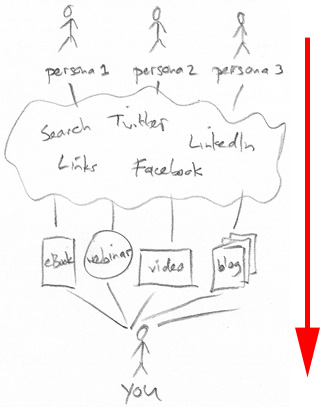Today my article on Content Marketing was published on the Genius.com blog, and I wondered whether I could visualize how Content Marketing is different from traditional public relations and advertising. I came up with two low-fi sketches. I’m interested to hear your opinion on these visualizations.
The OLD Situation
This visual reads from the bottom up: as a marketing manager, you hire a PR agency and an Ad Agency. You give them a briefing, and they create press releases and advertisements that tout your products. They use a lot of superlatives: “easy to use”, “seamless integration”, “powerful” and so on. This is blasted out to a mass audience. Ad Agencies can just buy the ad space to get eyeballs, but you pay dearly for it. PR Agencies blast it out to journalists, try to get some journalists on the phone, and hope they write an article about it.
The NEW Situation
In the new situation your read from the top down. You start defining the personas that you target, and you find out how to reach them through Social Media. You choose the mix of channels that they prefer (ebooks, webinars, video, blogs, podcasts, and so on) and create compelling content. As you get feedback from the prospects, you refine your content in an iterative way.
Black and White
This is a very rough comparison, and it’s easy to come up with objections. For example, in the old situation you were also thinking about your audience, you just didn’t have all the tools to narrow down the audience. And in the new situation it looks like to can do it yourself: however, you probably still need an agency for strategy and/or graphic design. Despite the shortcuts, I hope the images illustrate why Content Marketing is so popular. Let me know your take!




Hey Jep. I’d say that your diagrams are pretty much spot on in terms of how things *can* be done. Social Media is a superb toolset for *direct* contact/conversation/distribution of whatever the hell content you want. For most orghanisations I’d say it’s an essential part of the marketing mix.
Nice one. Keep up the scribbles : ) Love them.
I agree that content marketing is certainly presenting new, and perhaps more effective ways for marketers to get their messages out to their target audiences than traditional approaches to PR. However, I would argue that traditional PR still has a place in a company’s overall marketing strategy – it’s just now sitting alongside content marketing, and can often have some overlap. For example, a particular corporate blog post or white paper can be re-purposed as a contributed article in a relevant industry publication. Also, customer quotes from a podcast interview can be incorporated into press materials (press releases, case studies, etc.) – and the multimedia content can also be used to improve a press release’s chances for pick-up. These are just a couple of examples but there are many more.
Interesting discussion – thanks for sharing your thoughts.
Have you checked out Balsamiq?
great succinct article Jep, and love the diagrams. This is the way that advisory services are moving, even here in the Nordic markets. However the tough question is how many PR/advertising firms can make the jump into “editorial” driven marketing. This requires a much deeper appreciation of a client´s marketspace, business model and not least, how to hold the clients hand whilst they learn this new marketing language…..
Thank you all for the comments!
@ Roger: “*direct* contact/conversation/distribution” sums it all up
@ Nancy: great suggestions to reuse social media content for PR!
@ Erik: no, but will do
@ Russell: “learning this new marketing language” is indeed a challenge for many
Nice one.
I’d suggest that the red arrow in the ‘today’ sketch should go both ways. I know you’re suggesting reading it from the top down, but good content marketing is two-way while the old broadcast model was one-way.
That’s a very interesting diagram, Jep. And it does illustrate the change in power from marketer to buyer. It also illustrates the complexity of content management and the high level of personalization needed.
I also agree with the earlier commenter that the bottom diagram should have arrows going both ways.
Nice illustration though.
Jeff Ogden, President
Find New Customers
http://www.findnewcustomers.net
Jep,
The diagrams are oh-so-right. Have you thought of making a CommonCraft video – you’d be good at giving a no-frills account of the changes happening.
@ Doug: that’s a good point. I indeed intended the arrow as the reading direction, but content marketing is indeed more of a continuous feedback loop.
@ Jeff: indeed illustrates the power change from marketer to buyer, didn’t think of that yet.
@ Glenn: I will look into CommonCraft, thanks for the suggestion
“As you get feedback from the prospects, you refine your content in an iterative way.” The tools and processes for this will be key.
It takes forever to approve landing pages, emails, datasheets, whitepapers, etc. so I am curious how real-time content tweaking (which I fully support and see as key to demand gen) is achieved.
What are the toolsets folks are using to make this happen?
Janet, agree that tools and processes are very important to make this work. Although real-time adjustments would be great, I was assuming it would be more evolutionary. If I look at the LeadSloth blog, my topics and writing style have evolved over time, as a response to user feedback. This was step-by-step. Of course, I don’t have to go through lengthy approval processes. Document management, content management and marketing resource management systems can manage approval processes: but that’s not necessarily making it faster, just more reliable. Hope this helps.